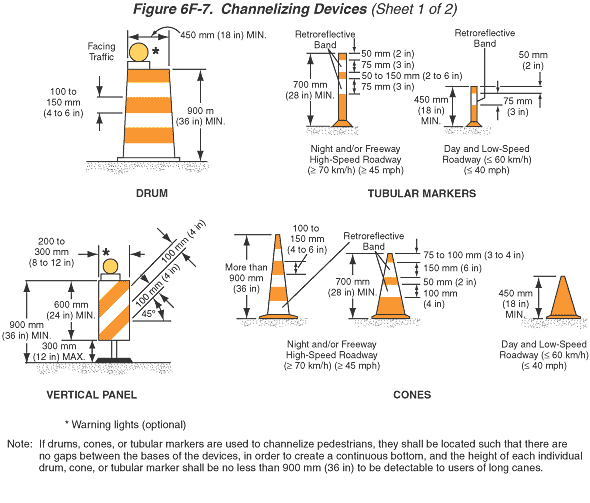|

Figure 6F-7. Channelizing Devices (Sheet 1 of 2)
This figure illustrates 10 channelizing devices on two sheets.
Sheet 1 shows six examples of four types of channelizing devices:
drums, tubular markers, vertical panels, and cones.
The illustration labeled "Drum" shows a vertically-oriented
tubular shaped device, with a base slightly wider than at the top.
The height is shown as "900 mm (36 in) MIN." The dimension
across the top is shown as "450 mm (18 in) MIN." A yellow
circle on a white rectangular base is shown above the top-left corner
of the drum and is accompanied by the notation "facing traffic"
and an asterisk. A note indicates that the asterisk means "Warning
Lights (optional)." The body of the drum is shown with alternating
orange and white horizontal stripes; the width of each stripe is
shown as a dimension of "100 to 150 mm (4 to 6 in)."
The illustration labeled "Tubular Markers" shows two
different markers:
- The first tubular marker is labeled "Night and/or Freeway
High-Speed Roadway (equal to or above 70 km/h (45 mph)."
It is shown as a narrow vertical tube on a base. The dimension
from the bottom of the base to the top of the tube is shown as
"700 mm (28 in) MIN." The base and the tube are shown
as orange in color. Two parallel horizontal white areas labeled
as "Retroreflective Bands" are shown covering 75 mm
(3 in) high sections of the tube at two specific locations on
the tube. The top of the topmost of the two white bands is shown
as 50 mm (2 in) below the top of the tube, and the space between
the two white bands is shown as "50 mm to 150 mm (2 to 6
in.)."
- The second tubular marker is labeled "Day and Low-Speed
Roadway (less than or equal to 60 km/h (40 mph)." It is shown
as a short narrow vertical tube on a base. The dimension from
the bottom of the base to the top of the tube is shown as "700
mm (28 in) MIN." The base and the tube are shown as orange
in color. One horizontal white area labeled as "Retroreflective
Band" is shown covering a 75 mm (3 in) high section of the
tube. The top of the white band is shown as 50 mm (2 in) below
the top of the tube.
The illustration labeled "Vertical Panel" is shown as
a vertical horizontal rectangular panel mounted on a pole protruding
vertically out of a flat base. The rectangular panel is shown with
a height shown as a dimension of "600 mm (24 in) MIN."
and a width shown as a dimension of "200 to 300 mm (8 to 12
in)." The dimension from the bottom of the base to the bottom
of the rectangular panel is shown as "300 mm (12 in) MIN.,"
and the dimension from the bottom of the base to the top of the
rectangular panel is shown as "900 mm (36 in) MAX." The
rectangular panel is shown covered with alternating white and orange
diagonal stripes running from top left toward bottom right at a
45-degree angle. The width of each stripe is shown as a dimension
of "100 mm (4 in)." A yellow circle on a white rectangular
base is shown above the top-left corner of the panel and is accompanied
by an asterisk. A note indicates that the asterisk means "Warning
Lights (optional)."
Three illustrations labeled "Cones" show three different
types of cones:
- The first two cones are labeled "Night and/or Freeway,
High-Speed Roadway, (equal to or above 70 km/h (45 mph)."
The first cone is shown as a flared tubular shape with a base
wider than the tip. The dimension from the bottom of the base
to the top of the cone is shown as "More than 900 mm (36
in)." The cone and its base are shown as orange in color.
Three parallel horizontal white areas labeled as "Retroreflective
Bands" are shown covering sections of the cone at three specific
locations on the cone. The space between the two topmost white
bands is shown as "100 to 150 mm (4 to 6 in.)."
- The second cone is shown as a flared tubular shape with a base
much wider than the tip. The dimension from the bottom of the
base to the top of the cone is shown as "700 mm (28 in) MIN."
The cone and its base are shown as orange in color. Two parallel
horizontal white areas labeled as "Retroreflective Bands"
are shown covering sections of the cone at two specific locations
on the cone. The top of the topmost of the two white bands is
shown as 75 to 100 mm (3 to 4 in) below the top of the cone. The
height of the topmost white band is shown as "150 mm (6 in),"
and the space between the two white bands is shown as "50
mm (2 in.)." The height of the lower white band is shown
as "100 mm (4 in)."
- The third cone is labeled "Day and Low-Speed Roadway (less
than or equal to 60 km/h (40 mph)." It is shown as a short
flared tubular shape, with a base much wider than the tip and
is shown as orange in color. The dimension from the bottom of
the base to the top of the cone is shown as "450 mm (18 in)
MIN."
A note at the bottom of Sheet 1 states "If drums, cones, or
tubular markers are used to channelize pedestrians, they shall be
located such that there are no gaps between the bases of the devices,
in order to create a continuous bottom, and the height of each individual
drum, cone, or tubular marker shall be no less than 900 mm (36 in)
to be detectable to users of long canes."
Continue to: Sheet 2
Back
to Chapter 6F
|

